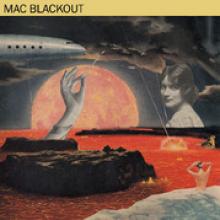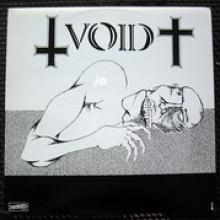Wally Shoup Qtet: An Ensemble Spread Out Over a Nation (Part Two)
At about this same time as this tape only release, in our nations’ capitol a young Radding was exercising his musicality within the “intensely serious” band, Age of Consent, before moving on to play with Dave Grohl in Dain Bramage. Each act was on the effete side of Punk, falling into the unfortunately named New Wave category.
While a Grohl collaborator, Radding, prompted to an encore in 1987, improvised a song after running through the entirety of the Dain Bramage cannon.
“All agreed that it was excellent,” Radding expounded, “but the others in the band refused to ever do it again!” Perhaps due to the uncertainty of the outcome, Radding’s band mates relegated him to servitude under others’ constructed musical writings.
Even if Shoup was a bit antiquated for what was ‘70s punk, Radding grew up amidst the flood of D.C. hardcore bands and in one way or another absorbed some of the attitudes that punk glorified: “anti-consumerism, self-determination and lack of aesthetic rules”. Championing those ideas was and will continue to coalesce scenes. But free-jazz or improvisers are still only figuring out how to take advantage of the market that still buys Sun Ship or Bap-Tizum. Radding observes that “nowadays the musicians in the jazz world are catching up with where we were 25 years ago, starting their own record labels, booking their own tours. Any music that doesn’t get much corporate or mass audience support is going to operate this way, with the artists and hardcore enthusiasts taking matters into their own hands.” No one can argue this point. And in a round about way, Shoup and Radding think the same thing, express it differently verbally and similarly musically.
Of the many avenues Shoup uses as a creative release, his website plays host to a few of his writings on music. In one essay he describes the relation between Punk and Free-Jazz. It’s interesting to note that he differentiates the Sex Pistols, the Damned and other assorted groups, as Punk Rock, not as Punk. Beefheart, he postulates, is Punk. And while that’s hard to argue, Beefheart was also a number of other things and is now a recluse. Ostensibly, the root of what Shoup seeks to uncover is the lack of precedent for tracing a music backwards. Beefheart was punk. There was not an antecedent. For that matter Zappa or Syd Barrett can be referred to as punk because what they did was an aural fuck all. The British Punk faire he mentions is criticized for substituting posturing for musical proclivity. Punk, in its most obvious form will keep the basic above ground musical tenets, which Shoup identifies as having a “keeper of the beat, player of the right notes at the right time in the right way.” The point he misses is that, Beefheart may have created a stirring racket that any listener in the ‘60s or ‘70s found alluring and subversive, but he never barked the lines “Fuck this and fuck that/Fuck it all and fuck a fucking brat” as Johnny Rotten did.
TWOFR: Mac Blackout x The Daily Void
Mac Blackout
Self Titled
(Dead Beat, 2008)
A t this point in the history of recorded musics it’s supremely difficult to examine a disc in a micro sense. Everything is related – it’s past the point of being ‘seemingly’ or ‘tangential.’ Even ignoring the output of Max Blackout as a part of a group, this self titled album forces the question, “Does this need to be disseminated to the masses?”
I dunno.
As unsettling as other projects that Mac Black out has been associated with – Functional Blackouts and Daily Void – this easily trumps his other discs in that one area. It’s creepy. It’s even more disquieting that the unlikely city this all sprung from was Indianapolis, where Mac attended art school during the late ‘90s. And despite the date of these recordings, there is an obvious ‘80s influence. How these songs have thus far avoided comparisons to the Screamers is beyond ludicrous, but there is a unifying sewer dwelling nihilism amidst each track.
Beyond that comparison, the lead off track “Everybody Rock”, still immediately recalls the Ramones’ “Happy Family.” It’s not that funny or poppy, but listeners may still extol a chortle. Ideally, there’d be a stand-out, alas there’s not. Lyrically, “Baby Face Killer” is easily recalled by simply leaning upon its Oh Brother! related title – or maybe “Nowhere Man,” because it’s a bloody Beatles song.
Mac Blackout (the album, not the man) should not cease existing, mostly because it’ll easily make a buck, but there are sporadic redeeming qualities throughout the solo offering – occasionally summoning Jay Reatard. Unfortunately, the scant rewards of Mac Blackout can be found elsewhere in a group setting – and occasionally in the same song – “You’ve Lost Your Eyes.”
The Daily Void
The Identification Code 5271- 4984953784-06564
(Dead Beat, 2007)
Dead Beat Records has relocated to good ole Cleveland, Ohio. And regardless of their office being in my hometown, they continue to release punk and garagey related ventures. Amidst some of the more standard music this imprint works with are a few idiosyncratic and unique acts.
The Daily Void have been culled from the disbanded Functional Blackouts, who over the relatively short while they were performing, created a dense aura around themselves: playing house shows throughout the Mid-West and the like.
With the demise of the FBs, Dr. Filth and cohorts sought to continue their legacy of disheveled punk with a slight evolution. The sound of DV is obviously in some way tied to the FBs, but not as fulfilling. It’s still punk and the music still attempts to relate a bleak future through each tune. There is a tangible difference. The same propulsion is present. The band is fast, sloppy and rugged but the sense of experimentation and lack of care is missing. Even their name points to a perception of life that may not result in maximum effort.
If you think shit doesn’t matter, why bother exerting yourself?
Where as each FBs’ release moved forward in some way, adding a new layer of post-punk nihilism and noise, this initial release from the Daily Void seems like a step back to a more basic and primordial time. The music is still balls out punk, but doesn’t maintain the urgency that the Functional Blackouts were able to bring to the fore.
“Tapewurm” does possess a great deal of noise atop of the steady punk beat and even a bit of rhythmic variety, but unfortunately, there really isn’t a succinct statement of their work. Instead, what becomes apparent is an obsession with insects. Comparisons and blatant statements like, “You’re not a man/You’re an insect”, do point to the prevalent perception of humanity as scum, but where in punk is that lacking?
The arduously screamed chorus of “Die Stiletto” works to cement the lack of concern for life, and it’s convincing. Considering the past association though, this delivery of not quite standard punk seems a bit centered. The future may not look upon this as kindly as previous FBs releases and E-bay certainly won’t find anyone to hock The Identification Code for holiday prices anytime soon.
Crystalized Movements: Independent Records and Updated Psych from the Eighties
You can’t pin point the end of Connecticut’s Crystallized Movements since the band ostensibly turned into front man Wayne Rogers’ next projects. The same players wouldn’t travel from band to band – or even from record to record. But what Roger’s is credited with during the early eighties is maintaining the tie between punky rock stuffs and psych freak-outs in the face of the Paisely Underground, the emerging shoe-gaze thing and reams of indie bands inflecting its music with faux-tripped out sounds.
First forming in 1979, Crystallized Movements was a basement project with Roger’s being accompanied by drummer Ed Boyden. Its initial recordings were all duo affairs with Rogers going back and adding additional guitar tracks to the whole thing.
Resulting in Mind Disaster, the tracks ape something of a Jap-psych thing – of course the lion’s share of that stuff had as of yet to fully inculcate the States. But the same vibe is present during Crystallized Movement’s most destructive passages – see the end of “Communal Storybook.”
Interestingly enough, following efforts like that drug damaged track is the almost pop like “Sandy Roy,” replete with hand claps and properly sung lyrics. Oddly enough, the guitar winds up sounding like what Operation Ivy would work up in the Bay five years on. Rogers’ vocals don’t move too far away from Jesse Michaels’ either: all spit and vigor, but in a teenaged angst kinda way.
Despite Mind Disaster’s ability to presage (although accidentally) a number of musics that would soon be hitting independent record stores, the willfully retro eighties’ garage bands and the groups associated with the Paisley Underground were apparently not impressed.
With Mind Disaster being greatly ignored here, the UK became an place where the band counted fans. This odd appointment – but not the first of its kind in the US rock world – continued on with the band eventually moving to Boston during the early nineties.
With the likes of Dinosaur Jr. and Sebadoh kicking around, there should have been a market for Rogers and the Crystallized Movements line up that coalesced in Boston. But that just wasn’t the case. Instead, Rogers founded another avenue to release music in the form of Magic Hour and Magic Stars, both of which garnered under-underground praise, if not widespread credentials.
Continuing to release music through his own label, Twisted Village, and running a record store has kept Rogers in the music world. If only the music world would be so kind as to keep him.
Brian Jonestown Massacre: How Many Albums is Enough in 1996?
The endless weirdness of Brian Jonestown Massacre front-man Anton Newcombe has been pretty well documented, mostly through the band’s extensive discography which finds him accompanied by a revolving door of Los Angeles’ psych music cognoscenti. The 2004 documentary Dig! worked to elucidate reasons for Newcombe’s changing company – and it did. The film details inter-band problems, the dissolution of friendships and whatever ever else rock bands go through.
What’s interesting, though, is that for a few years during the mid-nineties while everyone was recovering from the grunge hang-over levied on us by the music press, the Brian Jonestown Massacre released something like seven long playing albums in five years. Of course, the quality of some material is questionable – and even if it wasn’t, there’s no way for any fan to fully appreciate such a torrent of work during such a short period of time. The important fact being glossed over during that time – and even now – is that BJM was mining a genre that wouldn’t (re)enter the public consciousness for a few years.
Calling the band trailblazer’s would be patently ridiculous – they liked sixties’ rock stuff and recast it as their own bizarre trip. But amongst all slew of borrowed vibes and copped attitude were some truly consistent works. Again, issuing so much work almost guarantees that. A pair of records from 1996 – a year that saw three albums issued – constitute the band’s peak. And yes, that might some unintended double entendre.
Thank God For Mental Illness, while looking like it was an Oasis recording, is really a clutch of updated Bob Dylan run throughs. Borrowing melodies for “Ballad of Jim Jones,” a reference from where the band found its name, and any number of other songs can’t bog down the effort as it’s rendered in such good natured, folksy manner. The production values aren’t going to be pleasing to pop adherents, but if late sixities’ singer-songwriter stuff with an edge is your bag, so is this.
Shooting for a slightly different feel to its Take It From The Man!, BJM moves towards a gnarled garage style, not completely detached from Thank God, but indebted to the electric guitar more than group sung choruses and the harmonica.
The through line for all of this is the narcotic drawl each couplet is delivered with. Newcombe, or whoever’s handling the mic, sounds on the verge of sleep, but in a cool junkie kinda way. Suffice it to say, this isn’t for kids. It’s for grown folks that think they’re kids.
Circle Jerks - "I Just Want Some Skank" (Video)
Los Angeles Free Music Society: Black Humor
A few hours north of LA, in the Bay, Dan Houser wrangled together an assortment of players to work on various projects. It seems, though, that Houser’s penchant for punk and hardcore spilled over into all of his recording projects.
As the head of Fowl Records, Houser had a hand in producing a few of the Bay’s early hardcore efforts. The Fuck Ups, Urban Assault and Verbal Abuse each counted him as engineer for early singles. But sitting behind the boards wasn’t the only avenue Houser followed in the punk scene. Playing guitar even landed Houser in Precision Bearings, which counted as Fowl Records’ first release, as well as Good Samaritans.
Anyone remotely familiar with those acts – and that’s all that could really be asked – should be able to figure that the restrictive barriers in place counting as genre limitations wouldn’t be too artistically liberating after a while, if at all. Perhaps because of that, by 1982 Houser had formed Black Humor along with a random assemblage of creative musicians from around the area.
The band issued a long player through Fowl entitled Love God, Love One Another with acerbic wit firmly in place. Counting thirteen songs, the album didn’t really allow for listeners to hear the end of one composition as each sputtered, jerked and otherwise flopped into the next.
Out of the LAFMS stable, Black Humor being an extended family member, the band counts as one of the more indebted to punk and in-fact seems to presuppose a great deal of the Midwest’s noise-punk thing that resulted in bands like the Piranhas and its ilk. Everything from the screamed infantilism of its lyrics to the sometimes, murky almost industrial meanderings of the music, Black Humor attempted to confound its listeners.
This first record – there’d be a single as well as a tape only release over the next few years – finds the band (if that term can be applied here) working through its vast influences while still attempting to retain its punk aggression and attitude.
At times during the first half of the album, Black Humor apes an almost kraut-like repetition, tying the band to LA’s the Doo-Dooettes. As completely enthralling as the first half of the disc is, though, the second half devolves into minimal explorations of texture that aren’t as tuneful (obviously) or rhythmically intriguing as earlier efforts. It’s a mixed bag, for sure, but half of it’s worth whatever efforts listeners go through to track down the recording.
Los Angeles Free Music Society: Caroliner
Simply figuring out what incarnation of Caroliner one is having assault ear drums is difficult enough. Making it all the way through a recording is even more difficult, though.
As a latter day member of LAFMS, Caroliner doesn’t possess some of the traits common with better known groups from the collective. For instance, while there is a sense of repetition amidst the various compositions making up any long player from the group, there’s no semblance of a kraut influence. That, of course, doesn’t have any bearing on Caroliner’s membership (that’s probably not the right temr) in LAFMS, but it does set them apart.
But so too does the mythology behind the band.
Supposedly, Caroliner was a 19th century bull who wrote and performed original music. Right. The family that owned the bull, upon its death, ate the animal and was granted the catalog of songs in its memory. That can’t have been worth of. Of course, though, none of that happened, but it’s a wacky ass story to base a group on.
Regardless of the back story, Caroliner might count as the least listenable group affiliated with LAFMS. Music like this still requires a good deal of talent – Beefheart’s Magic Band, for instance, wielded considerably dexterity. Caroliner, has that atop of its monumental weirdness.
Contrasting views place Rear End Hernia Puppet Show’s release date in either ’85 or ’86. But that’s just peanuts. In whatever year, Caroliner was weirder than everything else that was recorded.
What’s least (or most?) engaging about the band is its singer’s strangulated hollers, apparently shared with the microphone on occasion through a fan. If one’s able to palette those vocals, the narcotic drawl to the bands music – when it’s not reaching for a weird almost thrash as on “Joy Disease” – is nothing but enticing.
The band’s decision to use a swinging rock thing as its musical basis – not country, although, that’s mentioned in countless other reviews detailing releases apart from this one – is really the only enticing thing here. Well, if not working with digital artifacts, the actual records are reportedly all hand made, some doused with garbage, some accompanied by odd, tossed off singles from the sixties.
So while, I personally, won’t be revisiting the Caroliner catalog, it seems that band members were able to conceive of a multi-media art project that attempted to bridge aural story telling, avant musics and visual art. Not bad for second rate LAFMSers.
Void: Half of Its Thrash Stinks, but Then There's the Good Stuff...
Figuring out what group first ushered in the metal influence within punk’s confines isn’t going to be agreed upon. But despite the various folks making the claim that Void, a Dischord hardcore band of the highest order dating to the early eighties, is the culprit, that’s not really accurate.
While the band followed in the wake of other local acts, though not necessarily taking direct cues from any, Void really just took the music to its logical, extraordinarily fast breaking point. There was an unquestionably Black Flag influence especially in Void guitarist Bubba Dupree’s tone and random experimentation with sheaths of feedback.
Beyond that and perhaps more importantly is the similarities between Darby Crash fronting the Germs and John Weiffenbach’s vocal approach in Void. The style isn’t unique to either figure, but Darby may have been the progenitor of screaming being voiced, phrased and pitched in that snotty manner. Of course, there’re hints of Stiv Bators from the Dead Boys in each. But that progression from Cleveland to Los Angeles to DC makes sense when examining how punk changed during the years 1975 and 1985.
Regardless of how Void arrived at its sound, the scant recordings that band made during its life span are all highly prized at this point. And while Condensed Flesh a taped demo the band made for Dischord is considered by many to be the band’s high point, it’s still difficult to listen to, which is in distinct contrast to the split Void unintentionally worked up with Faith. Dischord simply ended up with some recordings by each band and decided to issue the collection as a singular whole.
Whatever the impetus for the recording – and its inclusion of a few songs available elsewhere, including “Condensed Flesh”- Void’s songs here are the perfect distillation of punk moving through hardcore and into thrash. Noticeably absent, though, are the metallic inflections so many people make an issue of when discussing the band. That’s not to say that some of the breakdowns, shouted choruses and ridiculous tempos can’t be seen as the proper forbearer of whatever metal was during the eighties, but to levy the genre name on Void seems patently ridiculous.
The split’s penultimate track, “Think,” is a monstrous achievement for any band at any time. And while its difficult to hear if the band’s actually in time with itself, everything from Boston sounds to Bad Brains are there. That’s how good it is.








